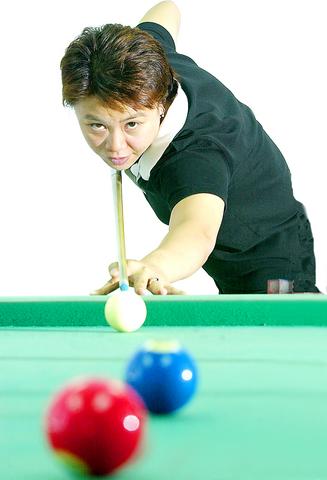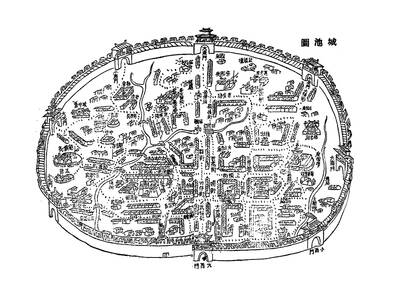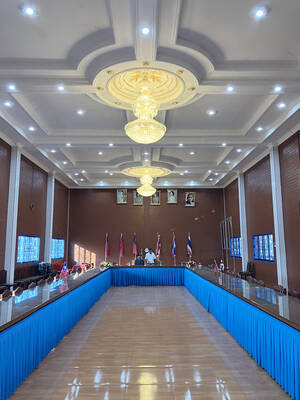Where there's a will, there's always a way. Few know this better than Taiwan's billiards queen, Liu Hsin-mei (
Beginning in 1993 with her first tournament win at the BCA US Open 14.1 Championship, she shot her way through title after title, gradually earning her monicker as Taiwan's own Billiards Queen (
Within days of her victory in Kaohsiung, Liu published her book, Taiwan A-mei (

PHOTO: CHEN CHENG-CHANG, TAIPEI TIMES
"I wanted to help tell a simple, touching story about a rebellious village girl who was once lost, but found her way again," Hsu said.
Tumultuous past
Liu's parents were both blind. The couple raised their four children solely by doing massage. By the age of 8, Liu was taking her mother and father by bicycle to people's houses for massage. But the help she offered her parents subsided when she became a teenager.
At 18, taken by a boyfriend, Liu began hanging out at pool halls, quickly becoming addicted to the game. She skipped half of her classes and spent hours in smoke-filled dens where she was usually the only girl.
"As long as I'm interested in something, I will indulge myself in it until I excel at it," Liu told the Taipei Times. "I'm just that kind of person."
In addition to her high school days spent at neighborhood pool halls in her home town of Loutung (羅東), Ilan County, Liu played tennis and volleyball and frequented the video arcades favored by her peers. But pool remained her passion. She was so taken by the game that even as her mother's lay on her deathbed, Liu was at a pool hall.
"Failing to see her face for the last time is the biggest regret of my life," Liu said. The days following high school were the darkest of her life.
She began working at a karaoke bar in Ilan, where drinking and drugs became a part of everyday life. "In the karaoke bar, when a customer wanted you to drink with them, you did," she says in her book.
There she also discovered amphetamines. "I was offered them by friends, and used them to fight fatigue ... but later I became a bit addicted to them. One time I tried to buy the stuff by myself and was ripped off. I spent thousands and got rock sugar," she writes in her book.
Ultimately, Liu decided to pick up her pool cue and take it to Taipei's famous pool clubs where she could learn from top players. Though her family strongly opposed her activities after her mother's death, she pleaded.
"Please let me play," Liu recalls telling her sister. "If I can't make it, I'll return home and find a job.
But in 10 years under the training of her coach, Chen Wei-chih (
"Liu's greatest asset is her ability to give consistently good performances. She may not have the camera appeal of other girls on the tour, such as Jennifer Chen (
Many sports commentators consider Liu's playing style to be moderate but consistent. "She has very solid skills. What's more, she's had intense training playing against a lot of men," said Simon Chang (
Lee agrees. "Like a male player, she has good coordination in using the strength of her wrist. This is something a lot of ladies don't do well."
Ambitious future
Away from the pool table Liu is dressed down and shows no trace of her trademark competitor's glare. She looks much younger and offers a broad, easy smile with a somewhat boyish temperament. At the age of 32, she's decided to return to school to become a teacher. She is now in her second year at the department of sports management of Taipei Physical Education College.
"I never thought I could be an `old' student," Liu said. "When I was young, I had no goals in my life. I always thought I would only live to 40. Now, I'm happy to see that I've accomplished a lot of things one by one," she said.
Liu has no plans to put down her pool cue any time soon. Winning another three international championships -- for a total of 10 -- is her next goal. She would also like to win at least two more WPA World 9-Ball Championships to equal or even surpass Alison Fisher's record of four.
Her only regret is that her parents could not see her success. Liu's father passed away just before her first World 9-Ball Champion in 1999.
"If I had the chance again, I would give up everything to take good care of them," she said.

May 26 to June 1 When the Qing Dynasty first took control over many parts of Taiwan in 1684, it roughly continued the Kingdom of Tungning’s administrative borders (see below), setting up one prefecture and three counties. The actual area of control covered today’s Chiayi, Tainan and Kaohsiung. The administrative center was in Taiwan Prefecture, in today’s Tainan. But as Han settlement expanded and due to rebellions and other international incidents, the administrative units became more complex. By the time Taiwan became a province of the Qing in 1887, there were three prefectures, eleven counties, three subprefectures and one directly-administered prefecture, with

Taiwan Power Co (Taipower, 台電) and the New Taipei City Government in May last year agreed to allow the activation of a spent fuel storage facility for the Jinshan Nuclear Power Plant in Shihmen District (石門). The deal ended eleven years of legal wrangling. According to the Taipower announcement, the city government engaged in repeated delays, failing to approve water and soil conservation plans. Taipower said at the time that plans for another dry storage facility for the Guosheng Nuclear Power Plant in New Taipei City’s Wanli District (萬里) remained stuck in legal limbo. Later that year an agreement was reached

What does the Taiwan People’s Party (TPP) in the Huang Kuo-chang (黃國昌) era stand for? What sets it apart from their allies, the Chinese Nationalist Party (KMT)? With some shifts in tone and emphasis, the KMT’s stances have not changed significantly since the late 2000s and the era of former president Ma Ying-jeou (馬英九). The Democratic Progressive Party’s (DPP) current platform formed in the mid-2010s under the guidance of Tsai Ing-wen (蔡英文), and current President William Lai (賴清德) campaigned on continuity. Though their ideological stances may be a bit stale, they have the advantage of being broadly understood by the voters.

In a high-rise office building in Taipei’s government district, the primary agency for maintaining links to Thailand’s 108 Yunnan villages — which are home to a population of around 200,000 descendants of the Chinese Nationalist Party (KMT) armies stranded in Thailand following the Chinese Civil War — is the Overseas Community Affairs Council (OCAC). Established in China in 1926, the OCAC was born of a mandate to support Chinese education, culture and economic development in far flung Chinese diaspora communities, which, especially in southeast Asia, had underwritten the military insurgencies against the Qing Dynasty that led to the founding of